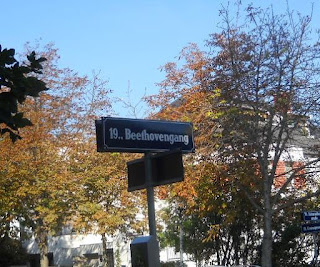Part 3 - Klimt's "Beethoven Frieze" - Heiligenstadt
Day 4
The first stop on Day 4 was another B. home, 22 Laimgrubengasse. He worked on the 9th Symphony here in 1822. This building is well-preserved and looks the same as it did when B. lived here. The front door was open so I walked inside a little bit to get the vibe. Just like Molker Bastei, it's surprisingly humble. Beethoven did not like the limelight and moved around alot to evade curiosity-seekers looking for the famous "deaf composer". The room where B. stayed at is open to visitors with an appointment. I decided to save that for another time. We headed on towards the Secession museum building where Gustav Klimt's "Beethoven Frieze" is on display. Frankly I wasn't too excited about it since it really had nothing to do with B.'s actual life in Vienna, but I ended up enjoying it quite alot. Klimt was commissioned to create this huge wall mural as part of the entrance to a massive Beethoven sculpture at this art exhibition. Mahler even made a special wind arrangement of the 9th Symphony for the event. Personally I'd never seen it before - but I loved it! This Klimt fellow is not bad at all. I think he has a real future ;).
 |
| Klimt "Beethoven Frieze" left wall... |
Our next stop was Heiligenstadt, where B. first stayed in 1802 and worked on the 2nd Symphony. More significantly, here he first realized that his deafness was not curable and was despondent enough to write a suicide note/last will. Fortunately he decided that "Art must live!" and the note (The "Heiligenstadt Testament") was not discovered until B.'s death 35 years later in a secret drawer in his desk. B. eventually stayed in Heiligenstadt several times, usually in the summer to escape the high heat of Vienna.
We took the U4 U-bahn which is Vienna's subway system. It was only 20 minutes by U-bahn, whereas in B's time it was 1.5 hours by horse-carriage. Many houses here are preserved from when B. stayed here, including 26 Kahlenberg
 |
| Huh? |
 |
| "There are no rules!" |
Moving away from the Heiligenstadt Park, we hit the 6 Probusgasse cottage which actually houses TWO independent Beethoven museums. The funny thing is, there's no hard evidence that B. lived in either of these apartments. Nonetheless it seemed likely to me that he did, just a vibe I got. Just like the Pasqualati House museum, the scores are all facsimiles, but everything else is genuine including a lock of Beethoven's hair (the piano however is not - as far as I know the only piano which Beethoven actually played which still survives is in Bonn, Germany). Again, the museums are fine and all but they don't say "Beethoven" to me, they say "museum". Some nice exhibits though.
 |
| Lock of The Maestro's hair. |
A little bit down the road is another B. home, at 2 Pfarrplatz which is a "proven" one. This abode has since been converted into a "heurigen" - wine tavern - where this season's wine can be sampled before it goes out to the public. They actually sold 2 types of Beethoven wine -"the Eroica" and "The Ninth". We chose the "in season" wine...The food was great here, we had sausages, stuffed peppers, pork - good diet food. Surely Beethoven could have sat exactly where I sat and eaten something very similar...
 |
| Wine tavern food. |
We left Heiligenstadt "well-sated" and returned to Vienna....
Searching for Beethoven in Heiligenstadt:
Click on the square pic below to see many more photos of Part 3.
You can watch here on Youtube as a slide show as well...
 |
| Vienna 3 |
To be concluded...





No comments:
Post a Comment